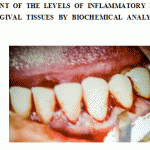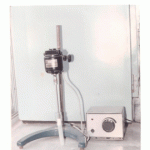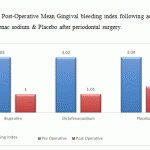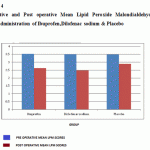How to Cite | Publication History | PlumX Article Matrix
G. Balaji Babu1, A. Raja2, R. Saranyan3, Majo Ambooken4, B. Manovijay5, J. Jaya Mary6
1Professor, Department Of Periodontics, Csi Dental College,Madurai. 2Professor,Departmentof Orthodontics, Vinayaka Mission’s Sankarachariyar Dental College, Salem. 3Professor,Departmentof Periodontics, Vinayaka Mission’s Sankarachariyar Dental College, Salem. 4Professor and Hod,Department Of Periodontics, Marbaselios Dental College, Kothamangalam. 5Senior Lecturer,Department Of Periodontics, Vinayaka Mission’s Sankarachariyar Dental College, Salem. 6Post Graduate Student,Department Of Periodontics, Vinayaka Mission’s Sankarachariyar Dental College, Salem.
ABSTRACT: Recent data have demonstrated increased levels of malondialdehyde (MDA)in gingival tissues of patients suffering from chronic periodontitis.This study examined the efficacy of Ibuprofen, Diclofenac sodium and placebo on the malondialdehyde levels before and after periodontal surgery. A double blind study was conducted on 20 male patients. MDA levels were assessed by Nichans and Samuelson Biochemical analysis.Statistical analysis was done by Kruskall Wallis and Friedmans test and p values were obtained. Mean pre and post-operative MDA levels were statistically significant at 1%. reduction in the levels of MDA following periodontal surgery were observed with the intake of both Ibuprofen and Diclofenac sodium than placebo.
KEYWORDS: Diclofenac sodium; Ibuprofen; Malondialdehyde; periodontal surgery
Download this article as:| Copy the following to cite this article: Babu G. B, Raja A, Saranyan R, Ambooken M, Manovijay B, Mary J. J. A Double Blind Study Comparing the Efficacy of Ibuprofen,Diclofena Sodium and Placebo on Lipid Peroxide- Malondialdehyde Levels In Gingival Tissue Before and after Periodontal Surgery. Biosci Biotech Res Asia 2015;12(2) |
Introduction
Peroxidation of lipids exposed to oxygen is responsible for damage to tissues and inflammatory diseases.1, 2The deleterious effects are initiated by free radicals produced during peroxide formation from fatty acids containing methylene-interrupted double bonds.3 Lipid peroxidation is a chain reaction providing a continuous supply of free radicals that initiate further peroxidation. Similarly lipidperoxides-malondialdehyde is formed during free radical injury in inflamed gingiva.
Lipid peroxides-Malondialdehyde a product of cyclooxygenase pathway is converted to protoglandins D, E, F as well as to Thromboxane (TXA2) and prostacyclin (PGI2).3
Inhibition of cyclooxygenase, the enzyme responsible for the biosynthesis of prostoglandins is generally thought to be the major facet of the mechanism of action of NSAID.4
Ibuprofen is the commonly prescribed anti-inflammatory drug following periodontal surgery.Ibuprofen inhibits the cyclooxygenase pathway thereby inhibiting the release of prostaglandins.5
Diclofenac possesses analgesic and anti-inflammatory action and is a known inhibitor of cyclooxygenase.In addition it appears to reduce intracellular concentrations of free arachidonates in leukocytes, perhaps by altering the uptake of fatty acid .6
The aim of this study was to compare the baseline level of inflammatory mediators (lipid peroxides – malondialdehyde) with post-operative level following administration of Ibuprofen,Diclofenac sodium and placebo after periodontal surgery.
Materials And Methods:
This study was conducted at the division of Periodontics,Rajah Muthiah Dental College and Hospital Chidambaram,Tamilnadu,India.
Inclusion and Exclusion Criteria
Chronic periodontitis patients with healthy systemic conditions who had not received any antibiotic therapy for the past 6 months were included in the study. Patients with systemic involvement such as diabetes, hypertension liver and kidney disorders and heart diseases were excluded. Persons who smoke, chew tobacco and consume alcohol were also excluded.
Twenty male patients who attended the dental op in the age group ranging from 30 to 40 diagnosed as chronic periodontitis were chosen for the study and were assessedperiodontally by using the following parameters.
Experimental parameters
- Gingival bleeding index(Muhlemann and Son 1971)7
- Assessment of the levels of inflammatory mediators(Lipid peroxides-Malondialdehyde) in the inflamed gingival tissues by biochemical analysis (Nichans and Samuelson 1967)8
The above parameters were recorded in a suitable proforma before and after periodontal surgery.
Informed consent of the patient was obtained.
 |
Figure:1 Assessment Of The Levels Of Inflammatory Mediators In Inflamed Gingival Tissues By Biochemical Analysis(Nichans And Samuelson ) |
Excision of the Tissue Sample For Determination of Malondialdehyde Level
After excision of the tissue sample approximately 500mg of tissue was homogenized (fig:2) in ice cold 0.025M Tris-Hydrochloride buffer(PH 7.5). An aliquot of this extract was used for the estimation of MDA, Hydroperoxides and conjugated dienes. Malondialdehyde level was estimated by the thiobarbituric acid assay method.
The tissue homogenate was prepared in 0-1 MTris-Hydrogen chloride buffer. 1ml of the homogenate was combined with 2ml of TCA-TBA-Hcl reagent and mixed thoroughly. The solution was heated for 15 minutes in a boiling water bath. After cooling the flocculent precipitate was removed by centrifugation at 1000g for 10 minutes. The absorbance of the sample wasread at 535nm against the blank that contained no tissue homogenate.
 |
Figure: 2 Tissue Homogeniser |
The patients were recalled after 4 weeks. The biopsy was taken from the adjacent tooth of the same quadrant and sent for biochemical analysis of malondialdehyde.
The results obtained in three groups after decoding were subjected to statistical analysis by using non-parametric Kruskwalwallis and Friedmans test.
Results
Table: 1 Pre-Operative and Post-Operative Mean and Standard Deviation of Gingival bleeding index following administration of Ibuprofen, Diclofenac sodium and placebo after periodontal surgery.
| Gingival
Bleeding Index |
Ibuprofen | Diclofenacsodium | Placebo | F Ratio | Significance | |||
| Mean
|
Standard
deviation |
Mean
|
Standard
deviation |
Mean
|
Standard
deviation |
|||
| Pre
Operative |
3.03 | 0.067 | 3.02 | 0.063 | 3.04 | 0.075 | ||
| Post Operative | 1.00 | 0.00 | 1.01 | 0.036 | 1.42 | 0.230 | ||
| Difference | 2.03 | 0.067 | 2.01 | 0.078 | 1.62 | 0.27 | 38.21 | P Value <0.01 |
 |
Figure: 3 Pre-operativeand Post-Operative Mean Gingival bleeding index following administration of Ibuprofen, Diclofenac sodium & Placebo after periodontal surgery. |
The following can be inferred from table1 and figure 3 given above
- The mean pre and postoperative gingival bleeding index difference between the three groups of drug is statistically significant.
- The mean reduction in post operative gingival bleeding index value was almost the same in both ibuprofen and diclofenac sodium groups but their reduction was more when compared to placebo group
Table: 2 Pre-Operative and Post-Operative Mean and Standard Deviation of Lipid Peroxides Malondialdehyde Following Administration of Diclofenac Sodium, Ibuprofen & Placebo
| Lipid
Peroxides Malondi- Aldehyde |
Ibuprofen | Diclofenacsodium | Placebo | F Ratio | Significance | |||
| Mean
|
Standard
deviation |
Mean
|
Standard
deviation |
Mean
|
Standard
deviation |
|||
| Pre
Operative |
3.52 | 0.164 | 3.50 | 0.177 | 3.49 | 0.160 | ||
| Post Operative | 2.62 | 0.176 | 2.48 | 0.149 | 2.89 | 0.163 | ||
| Difference | 0.90 | 0.079 | 1.01 | 0.122 | 0.60 | 0.097 | 89.38 | P < 0.01 |
 |
Figure 4: Pre operative and Post operative Mean Lipid Peroxide Malondialdehyde scores following administration of Ibuprofen,Dilofenac sodium & Placebo |
LPM — Lipid Peroxides Malondialdehyde
The following can be inferred from table 2 and figure 4 given above:
1)The mean pre and post-operative lipid peroxide malondialdehyde value difference between Ibuprofen,Diclofenac sodium and Placebo is statistically significant at 1%.
2)The mean reduction in post-operative lipid peroxide malondialdehyde value was almost the same in both Ibuprofen and diclofenac sodium but their reduction was more when compared to placebo.
Discussion
The present study was undertaken to compare the efficacy of Ibuprofen , Diclofenac sodium and placebo on gingival inflammation and malondialdehyde levels in a double blind study following modified Widman flap procedure performed in three quadrants of the same patient for three successive weeks in twenty male patients.
Under physiological conditions of normal cellular metabolism reactive oxygen species(ROS) are produced9.During chronic inflammation there is an overproduction of (ROS) and uncontrolled production of lipid peroxides contribute to injury of the host tissue.Recently more studies have focused on the role of lipid peroxide products in the pathogenesis of periodontitis10.
ElAtar (1981) measured the prostaglandin levels in normal and chronically inflamed samples of human gingival tissues and found a 20 fold increase of it in the inflamed tissues.11Both ibuprofen and diclofenac sodium exert their pharmacological properties by inhibiting the synthesis and release of prostaglandins and other eicosanoids(Vane1971). 12The findings of the present study also shows a reduction in malondialdehyde levels which is in concurrence with the above study as shown in table2 and fig 4
Goodson etal 198113 have established a significantly higher levels of prostaglandins in human periodontal tissues which were considerably reduced following periodontal surgery. The findings of the present study also showed a increase in malondialdehyde in gingival tissues and its reduction following administration of ibuprofen and diclofenac sodium afterperiodontal surgery.
The formation of Malondialdehyde a metabolite of prostaglandin endoperoxides detected in platelets may be used as an indicator of prostaglandin level in gingival tissues14. J.B. Smith etal 14observed considerable reduction in inflammation and fully epithelialized gingival crevice with a well-defined epithelial attachment is noticed only four weeks after periodontal surgery. Increase in the level of Malondialdehyde in inflamed gingival tissues and its reduction following administration of Ibuprofen,Diclofenac sodium and Placebo were observed after four weeks following periondontal surgery 15,16These findings correlated with the present study as were there was a considerable reduction in inflammation and fully epithelised gingival crevice 4 weeks after periodontal surgery as shown in table 2 and fig 4.
The use of bleeding rather than colour change is a more objective sign to detect gingival inflammation.Robert Armitage and Roy.C.Page 199017 showed a decrease in sulcular bleeding in the inflamed gingival tissues following administration of ibuprofen and diclofenac sodium and 4 weeks after periodontal surgery.The results of the present study was in concurrence with the above study as shown in table1 and fig 3.
From the above study it may be concluded that compared to placebo both Diclofenac sodium and Ibuprofen show more reduction in the level of inflammation and malondialdehyde levels following periodontal surgery.
References
- SreeramMeenakshi, SuryakarA.N.,DaniN.H.,Kalkarni M.B. A study of oxidative stress in periodontitis.Journal of Advance Researchers in Biological sciences 2013 Vol 5(4) 347-351.
- Marti RI, Agarwal N.K., Dash.D Pandey B.L. Effrct of NSAID on inflammatory burden, oxidative stress and platelet aggregability in hypertensive type 2 diabetes patients. Vascular Pharmacology 2007 Aug-Sep 47(2-3) 118-124.
- Harper’s Review of Biochemistry.Metabolism of lipids 20:223:1985
- CooperS.A..Ibuprofen in oral surgery a review journal of clinical pharmacology 28 (12 suppl) 40-46,1988
- HeasmanPA,Seymour RA. An association between long term non steroidalanti inflammatory drug therapy and the severity of periodontal diseases. Journal of clinical Periodontology 17;654-658:1990.
- Goodman and Gilman pharmacological basis of Therapeutics. 8(1) : 638:1990
- Muhleman H.R and Son S. Gingival sulcus bleeding-a leading symptom in initial gingivitis. Hell odontalActa 15;107:1971.
- Nichans and Samuelson. Formation of Malondialdehyde from phospholipid arachidonate during microsomal lipid peroxidation. European Journal Biochemistry.6: 126-130,1968.
- CooperS.A. NeedleS.E. Kruger G.O. Comparing analgesic potency of aspirin and ibuprofen.Journal of oral surgery 35,898,1977
- Cooper,Stand,BreenJ.F. GinlaniR.L.. Replicate studies comparing the relative efficacies of aspirin and ibuprofen in oral surgery outpatients. Journal of clinical pharmacology.19(2-3)151-159,1979.
- El Attar TMA, Zin H.S. prostaglandins in gingiva of patients with periodontal disease. Journal of periodontology 52,16-19,1981
- Vane J.R. Inhibition of prostaglandin synthesis as a mechanism of action of aspirin like drugs. Nature New Biology 231:232-235 1971.
- GoodsonJM,Dewhrist FF, Brunetti prostaglandin E2 levels and human periodontal disease prostaglandin 6:81-85,1974.
- J.B. Smith,CMIngerman and MJ.SilverMalon Malondialdehyde formation as an indicator of prostaglandin production by human platelets.Journal of Lab Clinical Medicine 1976.
- Glickman’s clinical periodontology, Healing after periodontal surgery 7:809:1990
- D.WeiXL,ZharyYZ,WangCX,Yang G Chen. Lipid peroxidation levels in chronic periodontitis patients before and after periodontal therapy.Australian Dental Journal ;55:70-78:2010.
- Robert.H.Johnson’Gary.C.ArmitageRoy.C.PageJournal of periodontal Research 25:230:1990.

This work is licensed under a Creative Commons Attribution 4.0 International License.





